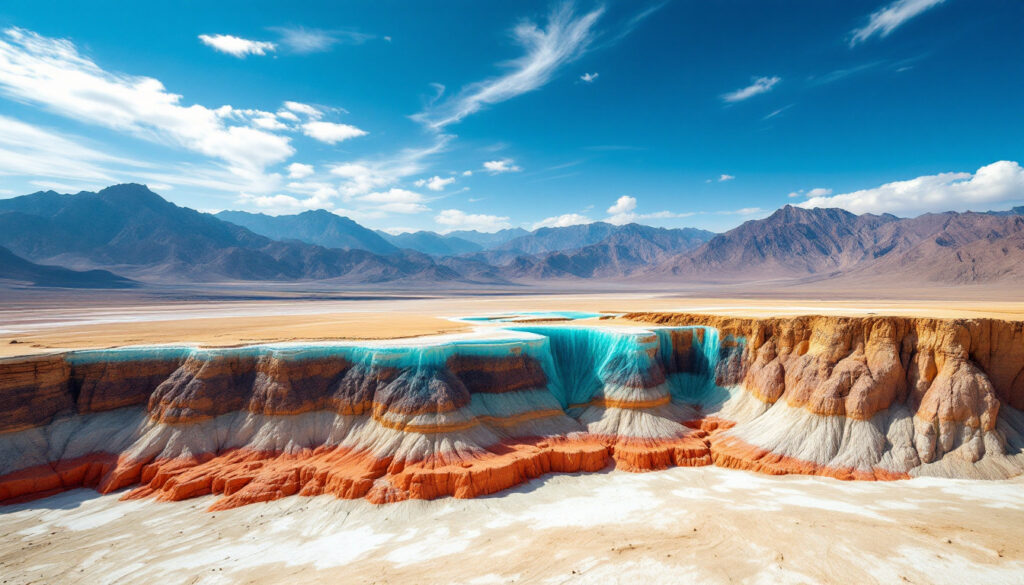The Precambrian Foundation: Death Valley's Oldest Rocks
1.7 Billion-Year-Old Basement Rocks
The Panamint and Black Mountains contain metamorphic schists and gneisses dating to 1.7 billion years ago, formed during tectonic collisions along Laurentia's margin. These collisions, part of the Rodinia supercontinent assembly, subjected sediments to intense heat and pressure, creating crystalline basement rocks.
These ancient foundation rocks represent some of North America's oldest geological formations, providing a window into Earth's early crustal development. When exposed in canyon walls, they appear as dark, contorted bands—physical evidence of the tremendous forces that shaped our continent's western edge.
From Active to Passive Margin
Rodinia's breakup ~750 million years ago (Ma) converted Laurentia's western margin into a passive boundary, allowing undisturbed sedimentation. Sandstone, siltstone, and limestone layers (1–0.6 billion years) preserved evidence of warm, shallow seas and Snowball Earth glaciations. MacDonald et al. identified Neoproterozoic climate cycles in these strata, linking them to early animal evolution.
This transition from active to passive margin created ideal conditions for the preservation of sedimentary sequences. The plate tectonics influence on these undisturbed layers function like pages in Earth's history book, recording environmental conditions across hundreds of millions of years with remarkable clarity.
Ancient Climate Events and Early Life
Snowball Earth Evidence
Neoproterozoic sedimentary sequences (~700 Ma) record global glaciation episodes, where ice sheets reached equatorial regions. Death Valley's strata show diamictites (glacial deposits) capped by carbonate layers, indicative of rapid warming and CO₂ fluctuations.
These glacial-interglacial cycles represent some of the most extreme climate oscillations in Earth's history, with global temperatures swinging from -50°C to +50°C within geologically short timeframes. Death Valley preserves this climate record better than almost any location worldwide, making it invaluable for paleoclimate research.
Early Animal Evolution
Paleozoic fossils chronicle life's diversification: Cambrian trilobites (500 Ma), Devonian jawless fish (400 Ma), and Carboniferous coral reefs (350 Ma). These fossils illustrate adaptive responses to post-Snowball Earth oxygenation and ecological niche expansion.
The transition from simple multicellular organisms to complex marine ecosystems can be traced in Death Valley's rock record. Some layers contain primordial sponge spicules and enigmatic Ediacaran impressions—evidence of life's first experiments with multicellularity before the Cambrian Explosion revolutionized Earth's biosphere.
How Did a Tropical Sea Become a Desert?
The Tectonic Dance of Island Arcs
Paleozoic subduction beneath offshore island arcs (e.g., Antler Orogeny, 350 Ma) alternated Laurentia's margin between active and passive states. Collisions accreted terranes, enriching the crust with mineral deposits.
This periodic collision of volcanic island chains with the ancient North American continent added new crustal material while generating mountain ranges that have since been eroded away. Each collision left distinctive mineral signatures, including copper, silver, and gold deposits that later attracted prospectors to Death Valley in the 19th century.
The Critical Shift in Subduction Direction
By 200 Ma, Farallon Plate subduction beneath Laurentia initiated Andean-style volcanism and crustal thickening. This reversal, from oceanic-arc to continental subduction, preconditioned western North America for Basin and Range extension.
The subduction angle gradually flattened over time, pushing volcanic activity progressively eastward. This shallow-angle subduction created a hydrated, weakened zone in the lower crust that would later facilitate the dramatic crustal stretching that formed Death Valley itself.
Basin and Range Formation: Creating Death Valley
Stretching of the Crust
Crustal stretching began ~20 Ma, facilitated by hydrated mantle wedge weakening. Normal faulting dropped blocks by 3–5 km, forming Death Valley (-282 feet) between the Panamint and Black Mountains.
This extension stretched the crust to approximately half its original thickness, creating the distinctive alternating mountain ranges and valleys that characterize the Basin and Range Province. In Death Valley, this thinning allowed the valley floor to drop dramatically while adjacent mountain blocks remained elevated, creating one of Earth's most extreme topographic gradients.
Active Fault Systems
The Furnace Creek Fault accommodates 2–6 mm/year extension, maintaining the valley's relief. Seismic activity includes minor quakes every few weeks and M6.5–7.0 events millennially. Badwater Basin continues subsiding, projected to deepen over millennia.
Geodetic measurements using GPS technology confirm that Death Valley continues to widen at roughly the rate human fingernails grow. This ongoing extension ensures that Death Valley remains geologically "alive," with its landscape actively evolving rather than merely eroding. The fault scarps visible along mountain fronts represent the surface expression of this continued movement.
From Lake to Desert: Death Valley's Recent History
The Pleistocene Lake System
Pleistocene Lake Manley spanned 100 miles (160 km), leaving evaporite minerals like borax and halite upon drying ~10,000 years ago. Playas like Badwater Basin retain hypersaline groundwater, supporting extremophiles.
During the last ice age, Death Valley resembled present-day Lake Tahoe more than the harsh desert we see today. Beaches and wave-cut terraces remain visible on hillsides up to 600 feet above the current valley floor, marking ancient shorelines of this vanished inland sea. As climate warmed around 10,000 years ago, evaporation outpaced precipitation, transforming the lush lakeside environment into today's extreme desert.
Ubehebe Crater: Volcanic Activity in Death Valley
A 2,100-year-old phreatomagmatic crater, Ubehebe formed via steam explosions as magma intruded groundwater-saturated faults. Ejecta include shattered sandstone and basaltic scoria, with the main crater spanning 0.5 miles.
The explosion that created Ubehebe was witnessed by indigenous peoples, whose oral histories describe a "mountain that blew its top." Archaeological evidence shows that toolmaking sites and temporary settlements were abandoned and covered by volcanic ash, providing rare correlation between human history and geological history of Death Valley.
How Do Death Valley's Unique Features Form?
What Makes the Rocks Move at Racetrack Playa?
Winter rains form ephemeral lakes, freezing overnight into ice sheets. Winds >10 mph push ice-embedded rocks across saturated playa mud, carving trails. Time-lapse photography confirmed this in 2014, solving a century-old mystery.
The moving rocks (or "sailing stones") represent one of Death Valley's most enigmatic phenomena. Some boulders weighing hundreds of pounds have been documented traveling hundreds of feet, leaving trails that sometimes make sharp turns or form parallel patterns. The conditions required for this movement occur only a few days per decade, making direct observation extremely rare until researchers deployed time-lapse cameras and weather stations in the early 2010s.
How Do the Mesquite Flat Sand Dunes Form?
Northwest winds transport quartz and feldspar sands from eroded granites, sorting grains into 100-foot-tall dunes. Annual migration rates of 1–2 meters reflect persistent aeolian activity.
The dunes represent a dynamic equilibrium between sand supply and wind transport. During storms, the dune crests can move several feet in a single day. The distinctive crescent shape of these barchan dunes results from winds predominantly blowing from one direction, creating steep slip faces on the leeward sides where sand accumulates before avalanching down at its angle of repose.
Understanding Death Valley's Extreme Environment
Why Is Death Valley So Dry?
Basin and Range topography creates a multi-stage rain shadow. Pacific storms lose moisture over the Sierra Nevada, Panamint, and Black Mountains, leaving Death Valley with <2 inches annual rainfall.
The Sierra Nevada mountains wring out approximately 80% of incoming Pacific moisture. The Panamint Range captures another 10-15%, leaving almost nothing for Death Valley itself. This sequential rain shadow effect makes Death Valley one of Earth's most efficient moisture traps, where annual evaporation potential exceeds 150 inches while actual precipitation averages just 1.9 inches.
Microbial Life in an Extreme Environment
Halophiles and thermophiles thrive in saline pools and hot springs, metabolizing sulfides and iron. NASA studies these microbes as Mars analogues, given similar oxidative stress and aridity.
These extremophiles produce distinctive biosignatures including carotenoid pigments that color some pools pink or orange. Astrobiologists use these chemical signatures to develop detection methods for potential extraterrestrial life. Recent research has identified microorganisms surviving in seemingly barren salt crusts by extracting moisture from the air during rare humid nights, demonstrating life's remarkable adaptability to extreme conditions.
FAQs About Death Valley's Geology
What is the lowest point in Death Valley?
Badwater Basin lies at 282 feet below sea level, the continental U.S. nadir. Ongoing faulting may lower it further.
Geophysical measurements indicate that sedimentary fill extends approximately 9,000 feet below the visible surface at Badwater Basin. This means the actual bedrock floor of Death Valley lies nearly two miles below sea level, making it one of Earth's deepest continental depressions when measured from bedrock to adjacent mountain peaks.
How old are the oldest rocks in Death Valley?
Precambrian schists and gneisses in surrounding mountains date to 1.7 billion years. These ancient basement rocks have survived multiple mountain-building episodes and represent the foundation upon which all of Death Valley's younger geological history of Death Valley is built.
What causes the colorful rock formations?
Iron oxidation states produce hues: green (Fe²⁺) and red (Fe³⁺) at Artist's Palette, from hydrothermal alteration. This palette of minerals results from ancient volcanic activity followed by mineral-rich fluids circulating through porous volcanic ash deposits, creating a natural canvas of extraordinary beauty.
Is Death Valley still geologically active?
Yes. The Furnace Creek Fault sustains extension, and Ubehebe's magma chamber remains seismically monitored. Geophysical surveys indicate that magma remains present at shallow depths beneath the northern valley, suggesting the possibility of future volcanic activity within human timescales.
Death Valley's geological history spans nearly 2 billion years—from ancient metamorphic basement to active fault systems still shaping its landscape today. This remarkable chronicle documents Earth's dynamic nature, from Precambrian supercontinents to Pleistocene ice ages and modern desertification. The formation of epithermal deposit formation and Carlin gold deposits in the region represents just one small chapter in the area's extensive geological narrative. Furthermore, the complex ore deposit geology and layered complex deposits found throughout the region tells a story of diverse mineral formation processes. As both the lowest and hottest location in North America, Death Valley represents an unparalleled natural laboratory for studying geological processes, climatic extremes, and life's adaptability to challenging environments.
Want to Spot the Next Major Mineral Discovery?
Discovery Alert's proprietary Discovery IQ model analyses ASX announcements in real-time, delivering instant notifications when significant mineral discoveries occur. Visit the Discovery Alert discoveries page to understand how these findings can generate substantial returns, and begin your 30-day free trial to position yourself ahead of the market.




